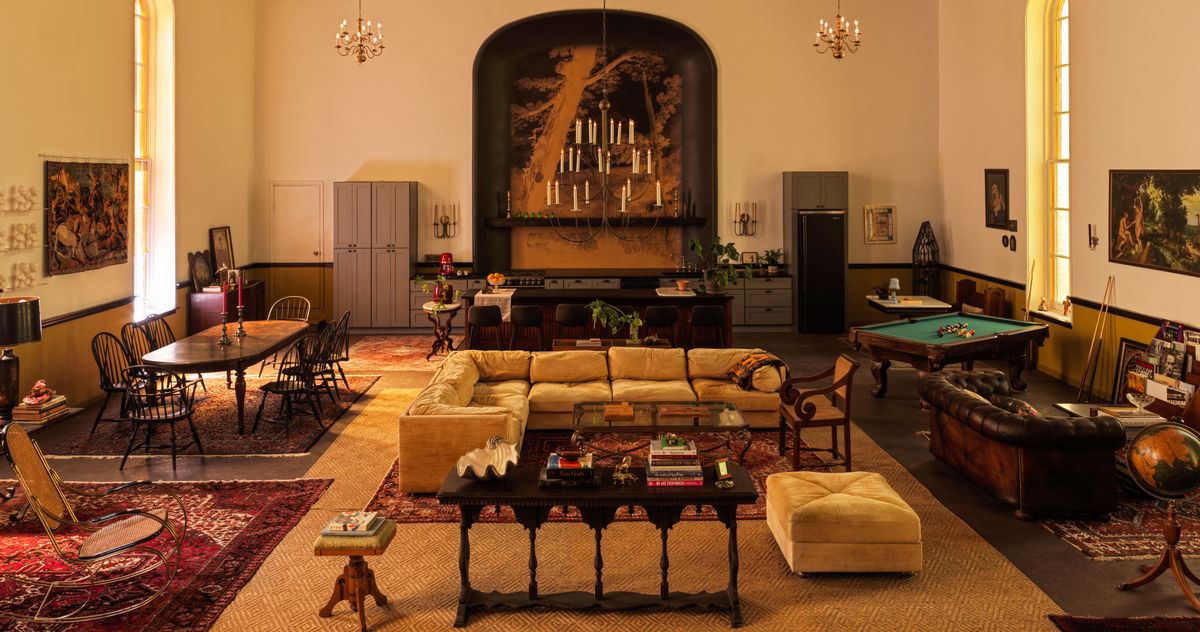
The Living Area: The church sanctuary is now mostly furnished with vintage finds. Many of the rugs came from AuctionNinja, and the sectional from Refill Vintage. “We wanted something substantial to fill up the space,” Cristiana Peña says, “and that felt like you could just melt into it.” The wallpaper in the kitchen niche from Fine & Dandy Co. was found by interior designer Jennifer L. Salvemini, who works for the HGTV show Who’s Afraid of a Cheap Old House?, which did an episode on the project.
Photo: Chris Mottalini
Cristiana Peña always wanted to live in something other than a regular house. Maybe a school, or a firehouse, or a store, she says. “But a church has always been on top of that list.”
In 2020, she and her partner, Nick Porter, were living together in her rental in a 1920s Tudor-revival building near Prospect Park. When the pandemic hit, they thought they wanted to get a place out of town. She has a master’s degree in historic preservation from Columbia and works for , a real-estate marketing platform that allows people to shop for antique homes around the country, which spawned an offshoot, Cheap Old Houses, that highlights less-expensive homes. It’s the basis for the show on HGTV, hosted by Elizabeth Finkelstein (who founded Circa Old Houses) and her husband, Ethan Finkelstein.
“I was just honestly along for the ride for a while,” says Porter. “It was Cristiana’s idea to move. She quickly focused on churches, but I was just assuming it would never happen, but I kind of got onboard more and more as time went on.”
Because Porter works at a communications firm in the city, he and Peña started out trying to keep their search within a two-hour commute. But the pandemic market was frustratingly competitive. “At every turn,” Peña says, “we were getting priced out by all-cash offers, and we just didn’t have that kind of finances behind us.”
Once they realized they both could work remotely, they expanded their search. They looked for a year and a half and saw at least five churches as well as several houses. “So many times during the process,” Peña says, “Nick would tell me, ‘You know, we could just buy some random house from the 1980s tomorrow and be done with it.’”
Then, in the summer of 2022, they found this 3,600-square-foot 1782 church in Granville. It had been vacant for a long time. They bought it for $99,000 from a couple across the street, who had intended to fix it up for their son. (At one point, a puppeteer was apparently interested in hosting a theater there and opened a hole into the basement.) It’s on less than an acre, but since it came with a small cottage, they were able to stay on the property during the renovation (which included fixing an unexpected mold problem).
“Overwhelmingly, and almost exclusively, we shop vintage and secondhand,” says Peña, who collects memorabilia related to Gainsborough’s Blue Boy that she finds in flea markets.
There is no central AC, and a heater was only recently installed after the expense of the mold removal was covered. The windows, some stained glass, are still painted shut. “But with the fans and such a big room,” Porter says, “it was pretty comfortable last summer.”
The Church: The Italianate Victorian details in the trim around the door and windows were added in the 1870’s, and Peña and Porter painted it. They also own the cottage next door.
Photo: Chris Mottalini
The Piano: “With so much space in the sanctuary,” Peña says, “we thought a piano would be a great investment. I played in my younger days, and Nick has been teaching himself on a keyboard.”
Photo: Chris Mottalini
The Niche Gallery: It’s over the sleeping area and holds Peña’s collection of Blue Boy paintings and objects.
Photo: Chris Mottalini
The Sleeping Area: “I refer to it as the ‘sleeping loft,’” says Peña. “My best guess is that it was the organ or choir loft, even though it is only elevated by two small steps.”
Photo: Chris Mottalini





